Abstract
Amiodarone is an antiarrhythmic agent unrelated to other drugs in current use. It has been little used in Britain, and no formal clinical trials have been possible because the drug has not been licensed by the Committee on Safety of Medicines. Nevertheless it has unique properties which can be valuable in the treatment of a wide spectrum of arrhythmias, particularly supraventricular tachycardias. Amiodarone has a slow onset of action and is cumulative. A sustained action is therefore achieved without the need for frequent maintenance dosage. Fifty patients have been treated with amiodarone in maintenance doses ranging from 200 mg on alternate days to 200 mg twice daily either alone, or in combination with conventional therapy. All were resistant to conventional therapy alone or could not be treated with usual agents because of unwanted drug effects. Of 27 patients with supraventricular arrhythmias, 18 were completely controlled and the other 9 were markedly improved. Six of 8 patients with recurrent life-threatening ventricular arrhythmias were well controlled symptomatically. Results were predictably less satisfactory in 15 high risk post-infarction patients with malignant arrhythmias and severe myocardial damage, but 6 were probably improved as a result of amiodarone. All patients on maintenance therapy for 3 months or more developed corneal microdeposits. None has any visual symptoms or other ocular defect, and treatment has not been curtailed as a result of this well recognized effect which is believed to be reversible and benign. Amiodarone can control patients with otherwise refractory arrhythmias including some which are life-threatening. Formal clinical trials are needed to define accurately its future role in the prevention and treatment of serious rhythm disorders of the heart.
Full text
PDF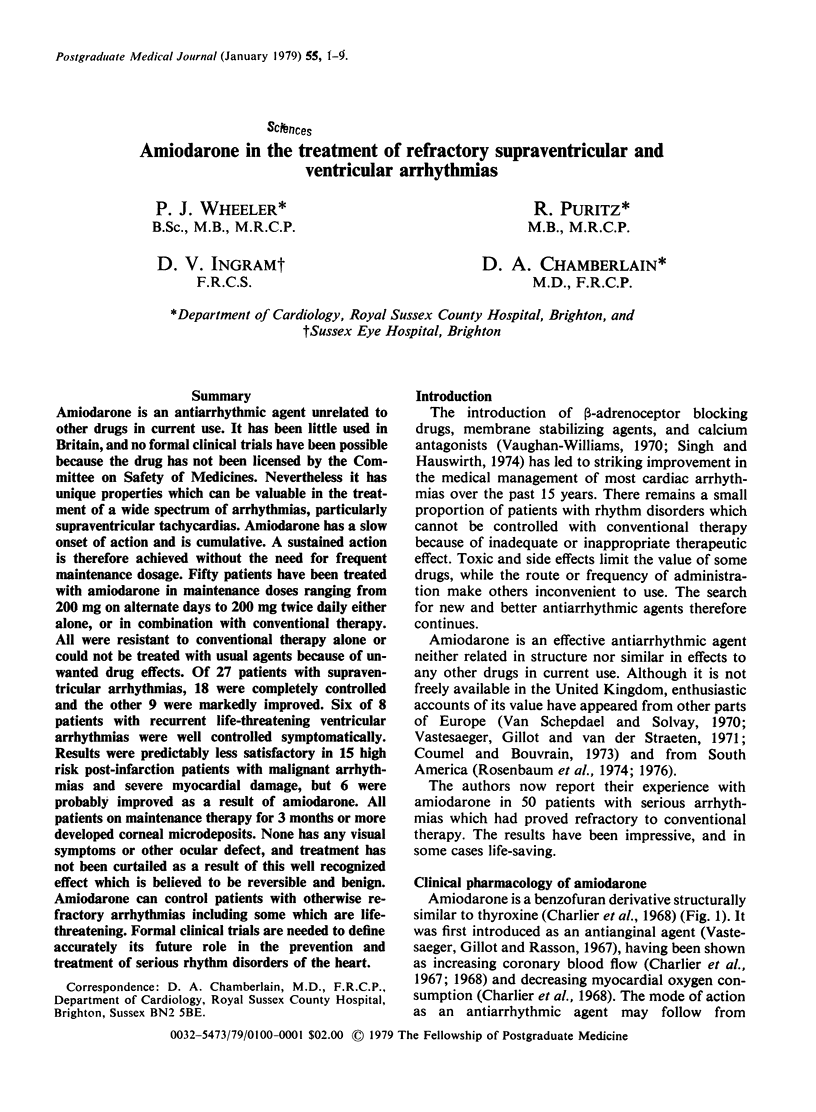
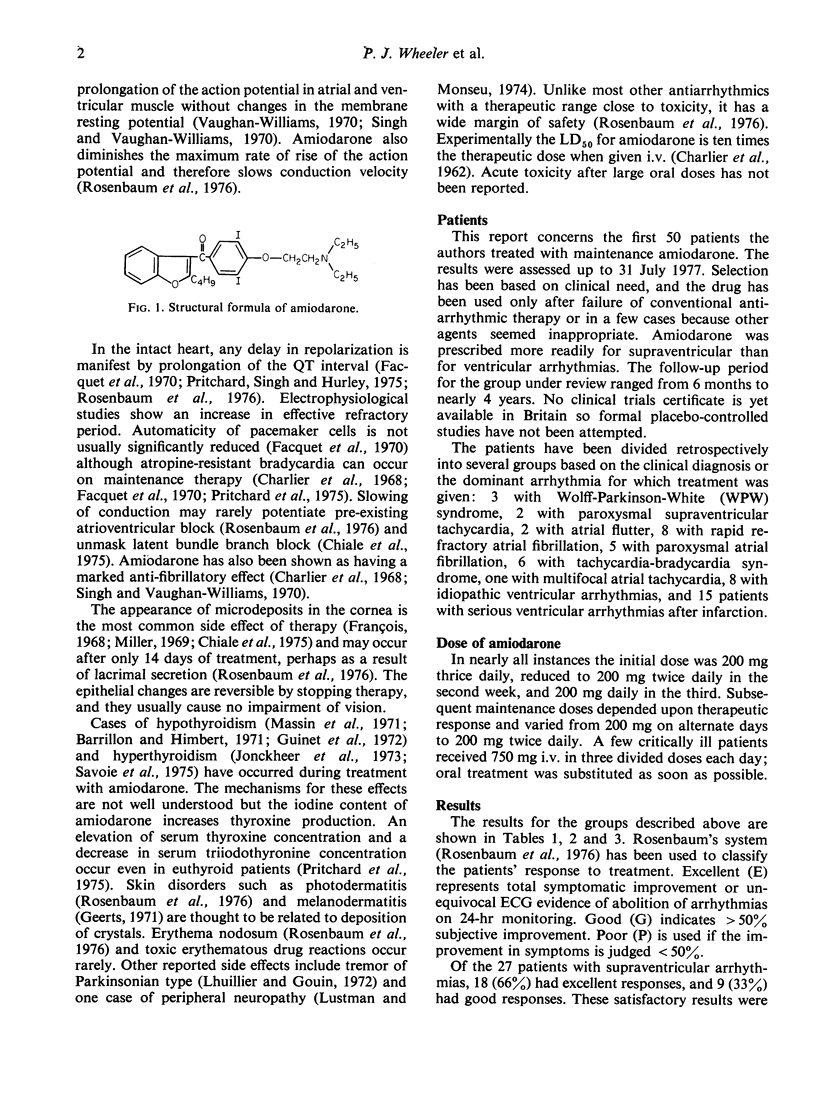
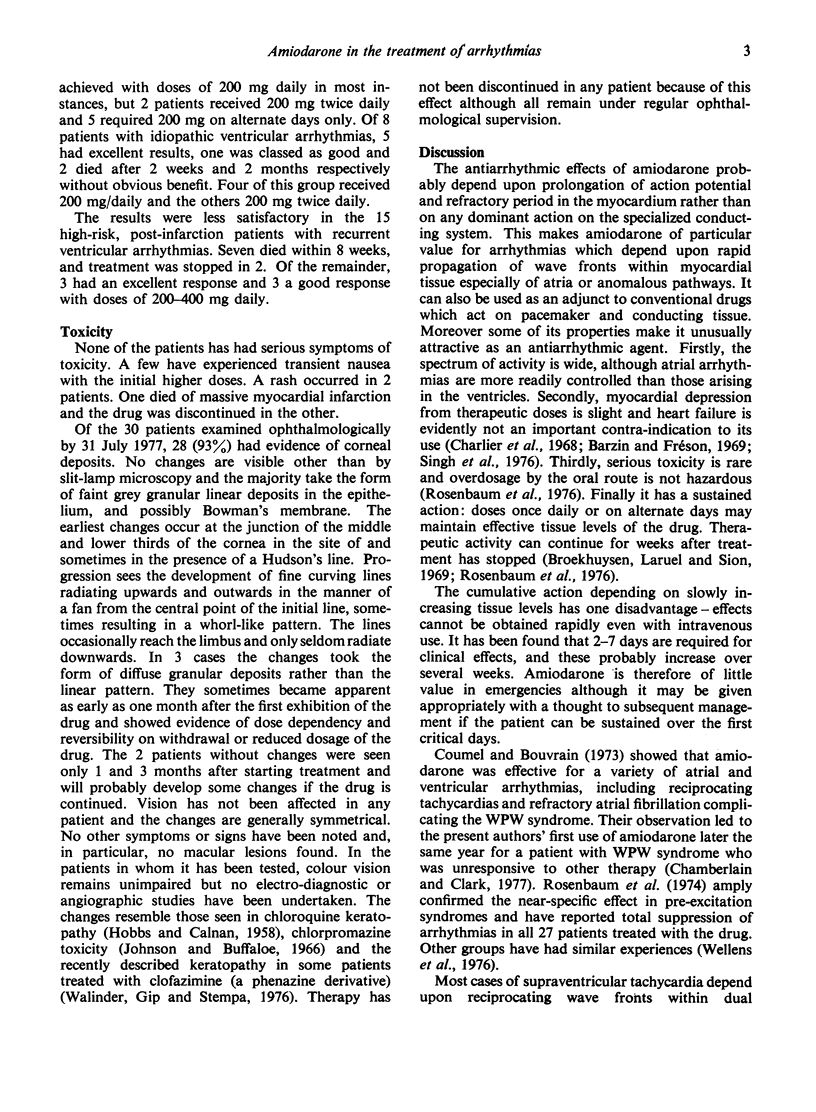
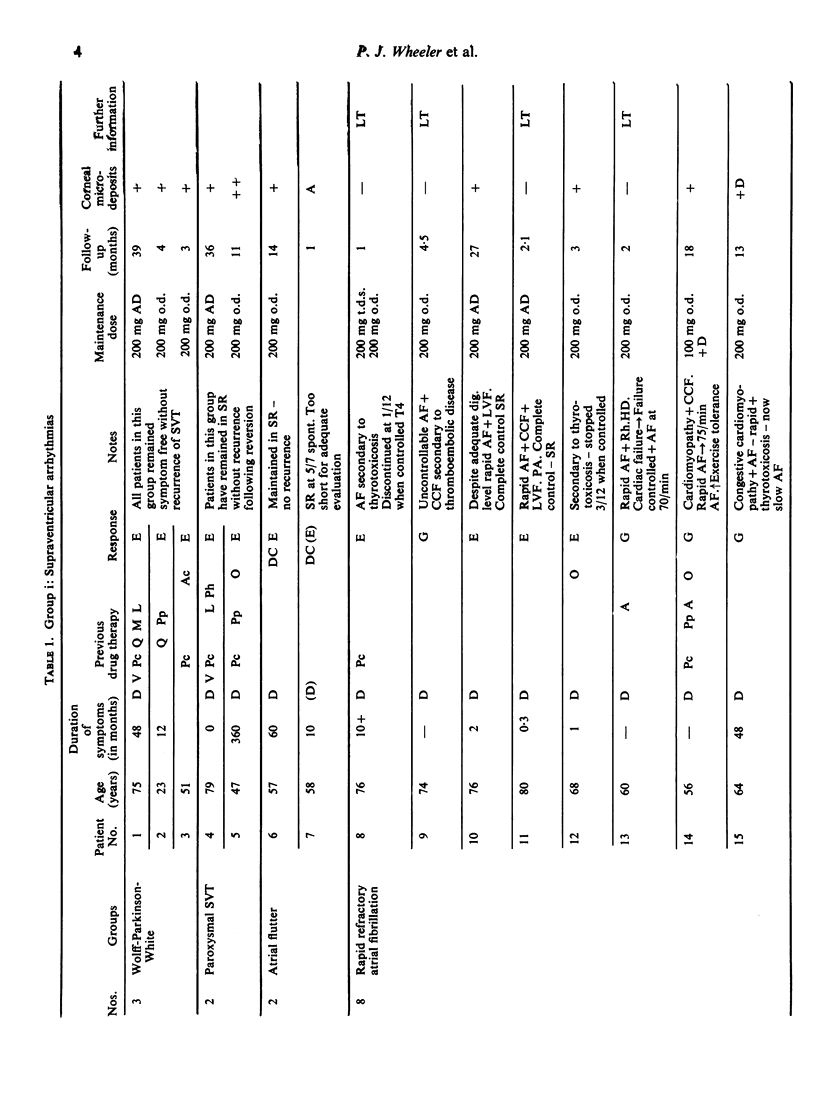
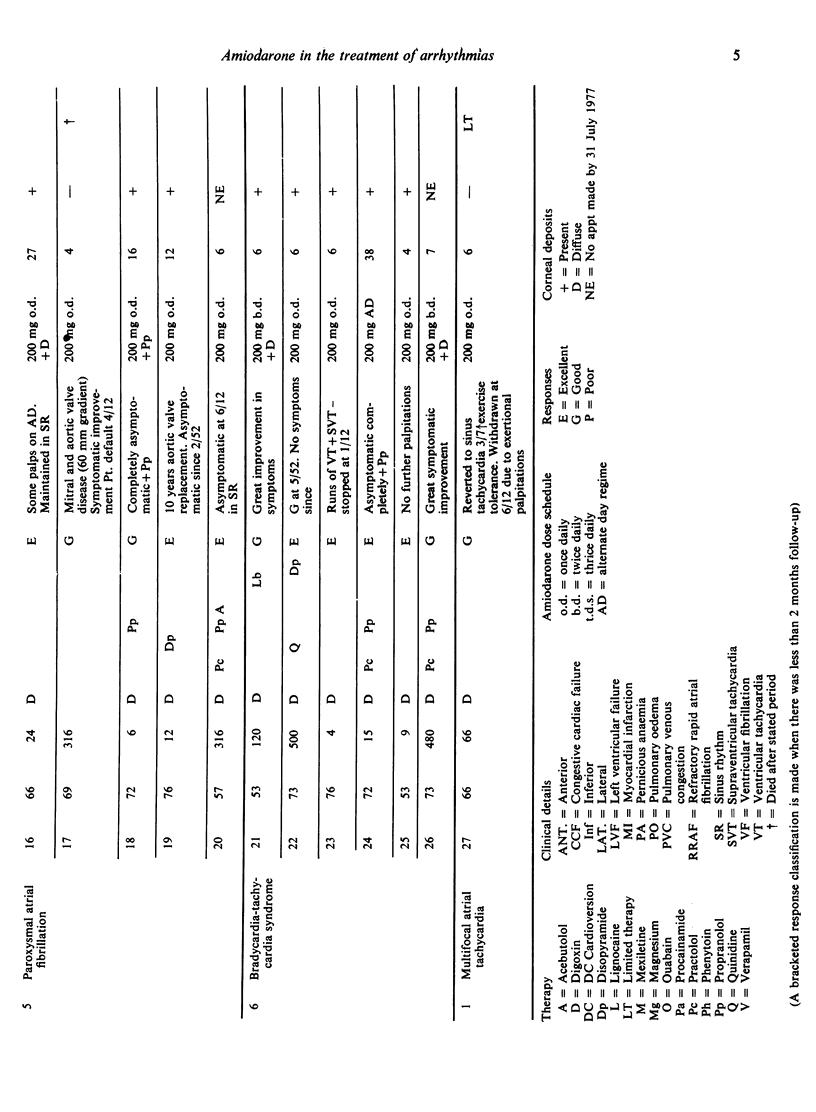
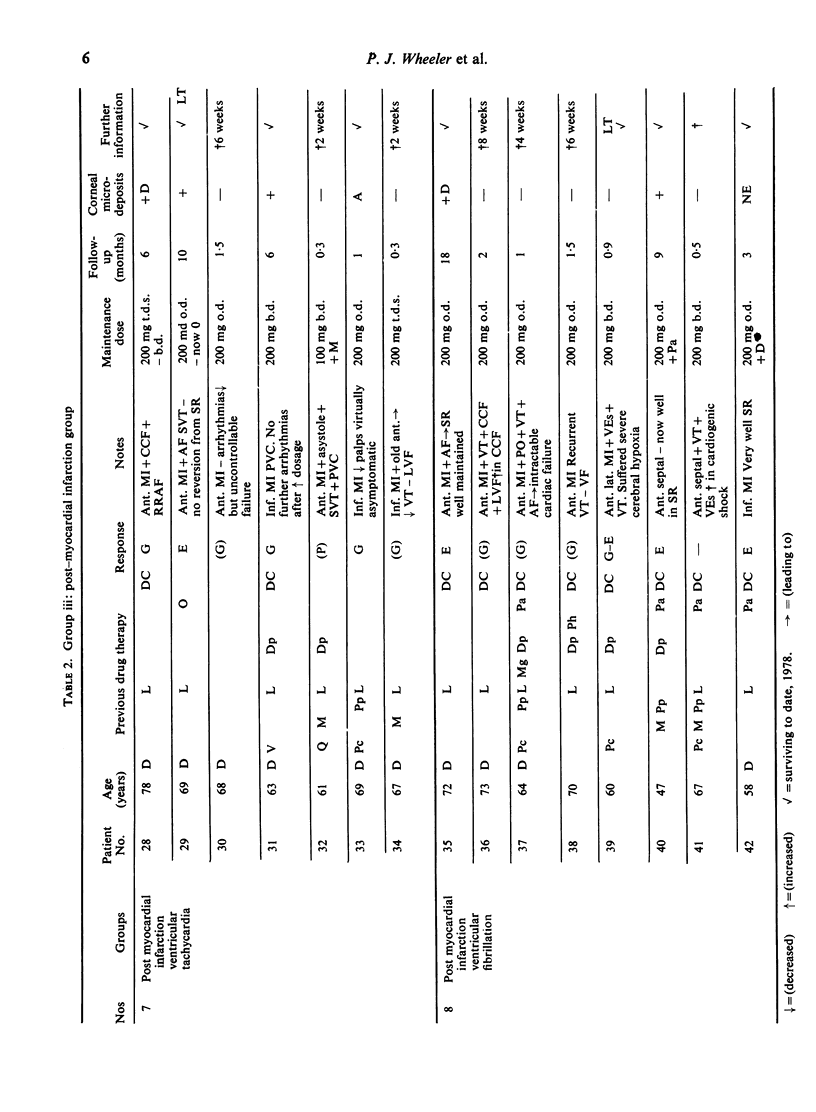
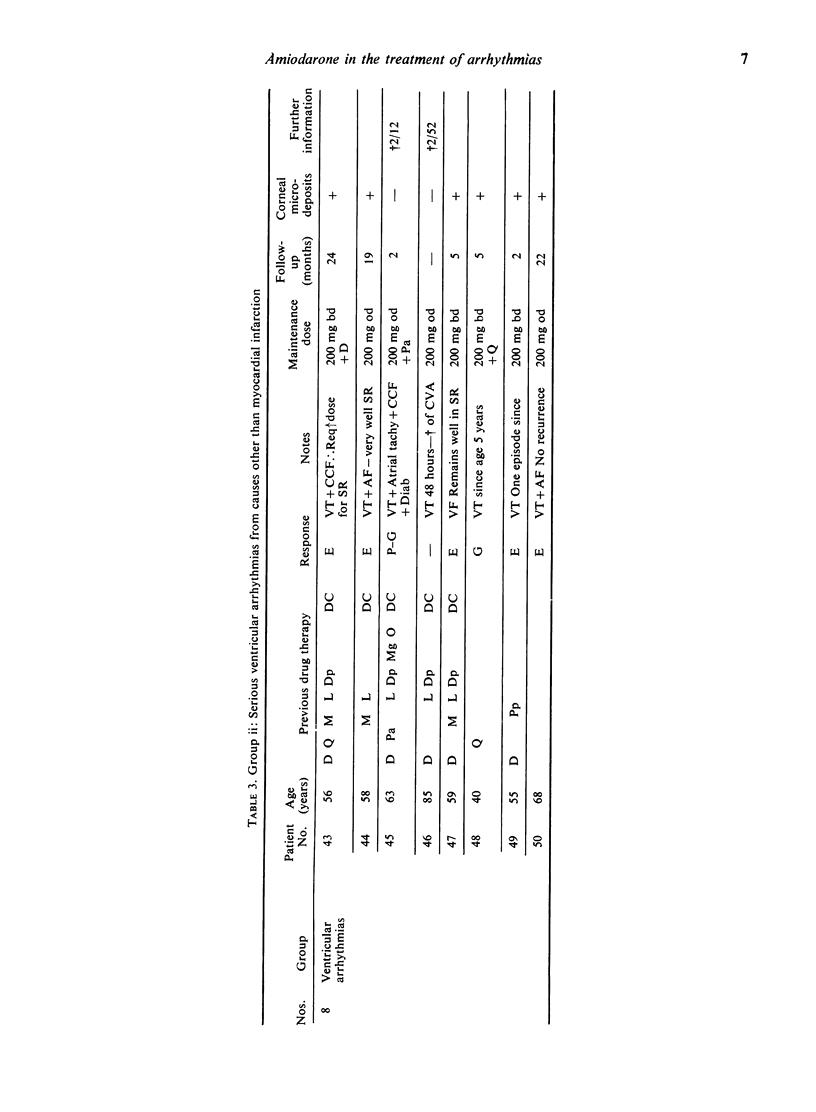
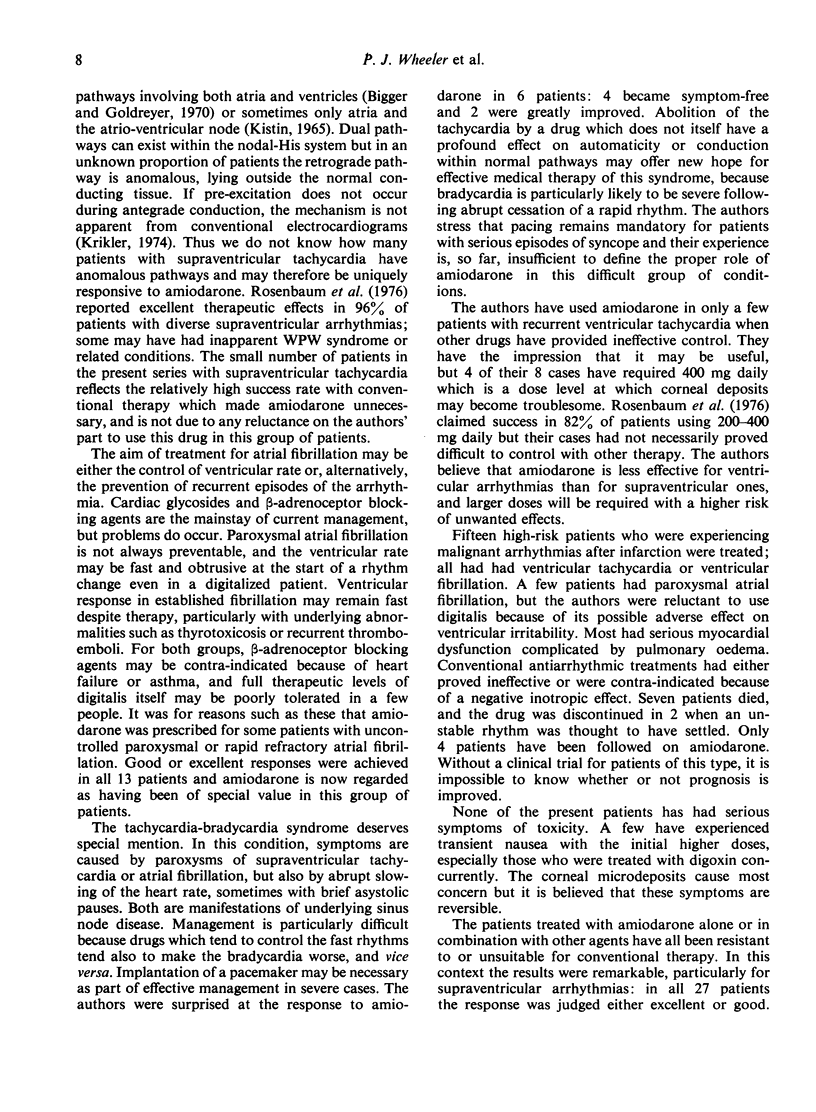
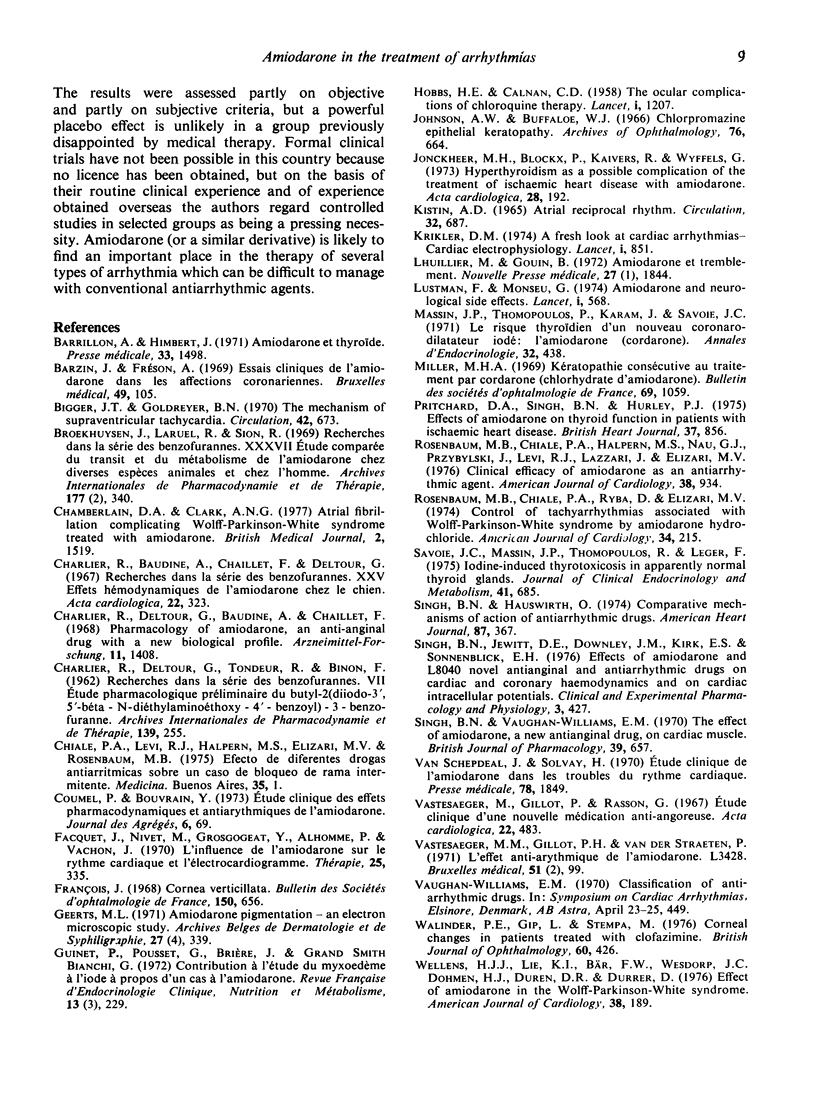
Selected References
These references are in PubMed. This may not be the complete list of references from this article.
- Barillon A., Himbert J. Amiodarone et thyroïde. Presse Med. 1971 Jul 3;79(33):1498–1498. [PubMed] [Google Scholar]
- Barzin J., Fréson A. Essais cliniques de l'aminodarone dans les affections coronariennes. Brux Med. 1969 Feb;49(2):105–122. [PubMed] [Google Scholar]
- Bigger J. T., Jr, Goldreyer B. N. The mechanism of supraventricular tachycardia. Circulation. 1970 Oct;42(4):673–688. doi: 10.1161/01.cir.42.4.673. [DOI] [PubMed] [Google Scholar]
- Broekhuysen J., Laruel R., Sion R. Recherches dans la série des benzofurannes. XXXVII. Etude comparée du transit et du métabolisme de l'amiodarone chez diverses espèces animales et chez l'homme. Arch Int Pharmacodyn Ther. 1969 Feb;177(2):340–359. [PubMed] [Google Scholar]
- CHARLIER R., DELTOUR G., TONDEUR R., BINON F. [Studies in the benzofuran series. VII. Preliminary pharmacological study of 2-butyl-3-(3,5-diiodo-4-beta-N-diethylaminoethoxybenzoyl)-benzofuran]. Arch Int Pharmacodyn Ther. 1962 Sep 1;139:255–264. [PubMed] [Google Scholar]
- Chamberlain D. A., Clark A. N. Atrial fibrillation complicating Wolff-Parkinson-White syndrome treated with amiodarone. Br Med J. 1977 Dec 10;2(6101):1519–1520. doi: 10.1136/bmj.2.6101.1519. [DOI] [PMC free article] [PubMed] [Google Scholar]
- Charlier R., Baudine A., Chaillet F., Deltour G. Recherches dans la série des benzofurannes. XXV. Effets hémodynamiques de l'amiodarone chez le chien. Acta Cardiol. 1967;22(4):323–349. [PubMed] [Google Scholar]
- Charlier R., Deltour G., Baudine A., Chaillet F. Pharmacology of amiodarone, and anti-anginal drug with a new biological profile. Arzneimittelforschung. 1968 Nov;18(11):1408–1417. [PubMed] [Google Scholar]
- Chiale P. A., Levi R. J., Halpern M. S., Elizari M. V., Rosenbaum M. B. Efecto de diferentes drogas antiarrítmicas sobre un caso de bloqueo de rama intermitente. Medicina (B Aires) 1975 Jan-Feb;35(1):1–13. [PubMed] [Google Scholar]
- Facquet J., Nivet M., Grosgogeat Y., Alhomme P., Vachon J. L'influence de l'aminodarone sur le rythme cardiaque et l'électrocardiogramme. Therapie. 1970 Mar-Apr;25(2):335–341. [PubMed] [Google Scholar]
- François J. Cornea verticillata. Bull Soc Belge Ophtalmol. 1968;150:656–670. [PubMed] [Google Scholar]
- Geerts M. L. Amiodarone pigmentation. An electron microscopic study. Arch Belg Dermatol Syphiligr. 1971 Oct-Dec;27(4):339–351. [PubMed] [Google Scholar]
- Guinet P., Pousset G., Briere J., Grand Smith Bianchi G. Contributin à l'étude du myxoedème à l'iode. A propos d'un cas à l'amiodarone. Rev Fr Endocrinol Clin. 1972 May-Jun;13(3):229–243. [PubMed] [Google Scholar]
- HOBBS H. E., CALNAN C. D. The ocular complications of chloroquine therapy. Lancet. 1958 Jun 7;1(7032):1207–1209. doi: 10.1016/s0140-6736(58)91911-1. [DOI] [PubMed] [Google Scholar]
- Johnson A. W., Buffaloe W. J. Chlorpromazine epithelial keratopathy. Arch Ophthalmol. 1966 Nov;76(5):664–667. doi: 10.1001/archopht.1966.03850010666007. [DOI] [PubMed] [Google Scholar]
- Jonckheer M. H., Blockx P., Kaivers R., Wyffels G. Hyperthyroidism as a possible complication of the treatment of ischemic heart disease with amiodarone. Acta Cardiol. 1973;28(2):192–200. [PubMed] [Google Scholar]
- Kistin A. D. Atrial reciprocal rhythm. Circulation. 1965 Nov;32(5):687–707. doi: 10.1161/01.cir.32.5.687. [DOI] [PubMed] [Google Scholar]
- Krikler D. M. Cardiac electrophysiology. Lancet. 1974 May 4;1(7862):851–854. doi: 10.1016/s0140-6736(74)90495-4. [DOI] [PubMed] [Google Scholar]
- Lhuillier M., Gouin B. Amiodarone et tremblement. Nouv Presse Med. 1972 Jul 1;1(27):1844–1844. [PubMed] [Google Scholar]
- Lustman F., Monseu G. Letter: Amiodarone and neurological side-effects. Lancet. 1974 Mar 30;1(7857):568–568. doi: 10.1016/s0140-6736(74)92757-3. [DOI] [PubMed] [Google Scholar]
- Massin J. P., Thomopoulos P., Karam J., Savoie J. C. Le risque thryoïdien d'un nouveau coronaro-dilatateur iodé: l'amiodarone (cordarone. Ann Endocrinol (Paris) 1971 May-Jun;32(3):438–448. [PubMed] [Google Scholar]
- Miller H. A. Kératopathie consécutive au traitement par cordarone (chlorhydrate d'amiodarone) Bull Soc Ophtalmol Fr. 1969 Dec;69(12):1059–1065. [PubMed] [Google Scholar]
- Pritchard D. A., Singh B. N., Hurley P. J. Effects of amiodarone on thyroid function in patients with ischaemic heart disease. Br Heart J. 1975 Aug;37(8):856–860. doi: 10.1136/hrt.37.8.856. [DOI] [PMC free article] [PubMed] [Google Scholar]
- Rosenbaum M. B., Chiale P. A., Halpern M. S., Nau G. J., Przybylski J., Levi R. J., Lázzari J. O., Elizari M. V. Clinical efficacy of amiodarone as an antiarrhythmic agent. Am J Cardiol. 1976 Dec;38(7):934–944. doi: 10.1016/0002-9149(76)90807-9. [DOI] [PubMed] [Google Scholar]
- Rosenbaum M. B., Chiale P. A., Ryba D., Elizari M. V. Control of tachyarrhythmias associated with Wolff-Parkinson-White syndrome by amiodarone hydrochloride. Am J Cardiol. 1974 Aug;34(2):215–223. doi: 10.1016/0002-9149(74)90200-8. [DOI] [PubMed] [Google Scholar]
- Savoie J. C., Massin J. P., Thomopoulos P., Leger F. Iodine-induced thyrotoxicosis in apparently normal thyroid glands. J Clin Endocrinol Metab. 1975 Oct;41(4):685–691. doi: 10.1210/jcem-41-4-685. [DOI] [PubMed] [Google Scholar]
- Singh B. N., Hauswirth O. Comparative mechanisms of action of antiarrhythmic drugs. Am Heart J. 1974 Mar;87(3):367–382. doi: 10.1016/0002-8703(74)90080-5. [DOI] [PubMed] [Google Scholar]
- Singh B. N., Jewitt D. E., Downey J. M., Kirk E. S., Sonnenblick E. H. Effects of amiodarone and L8040, novel antianginal and antiarrhythmic drugs, on cardiac and coronary haemodynamics and on cardiac intracellular potentials. Clin Exp Pharmacol Physiol. 1976 Sep-Oct;3(5):427–442. doi: 10.1111/j.1440-1681.1976.tb00620.x. [DOI] [PubMed] [Google Scholar]
- Singh B. N., Vaughan Williams E. M. The effect of amiodarone, a new anti-anginal drug, on cardiac muscle. Br J Pharmacol. 1970 Aug;39(4):657–667. doi: 10.1111/j.1476-5381.1970.tb09891.x. [DOI] [PMC free article] [PubMed] [Google Scholar]
- Van Schepdael J., Solvay H. Etude clinique de l'amiodarone dans les troubles du rythme cardiaque. Presse Med. 1970 Oct 10;78(42):1849–1850. [PubMed] [Google Scholar]
- Wellens H. J., Lie K. I., Bär F. W., Wesdorp J. C., Dohmen H. J., Düren D. R., Durrer D. Effect of amiodarone in the Wolff-Parkinson-White syndrome. Am J Cardiol. 1976 Aug;38(2):189–194. doi: 10.1016/0002-9149(76)90148-x. [DOI] [PubMed] [Google Scholar]


